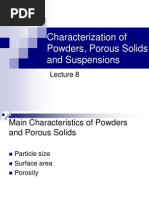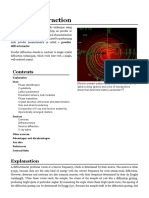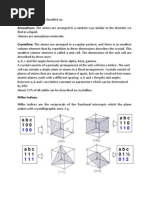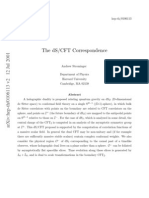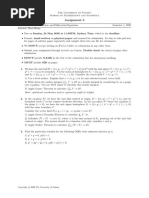0 ratings0% found this document useful (0 votes)
51 viewsWhat Is Particle Size
Information about particle size.
Uploaded by
cj-19843155Copyright
© © All Rights Reserved
Available Formats
Download as PDF, TXT or read online on Scribd
0 ratings0% found this document useful (0 votes)
51 viewsWhat Is Particle Size
Information about particle size.
Uploaded by
cj-19843155Copyright
© © All Rights Reserved
Available Formats
Download as PDF, TXT or read online on Scribd
You are on page 1/ 4
Brookhaven Instruments Corporation White Paper
What Is Particle Size?
By Bruce B. Weiner Ph.D., November 2010
Keywords: particle, particle size, ESD, image analysis,
hydrodynamic radius, Rh, radius of gyration, Rg
Introduction: The short answer is this: diameter or radius. But what type of diameter or radius, and what to do about non-spherical particles? The following introduces some ideas for
those who have never done particle sizing.
Length vs. Mass: If you are a particle technologist, then the only answer is length. But at a recent biochemistry national meeting, a group of
protein chemists continually referred to the molecular weight of a globular protein, a relative
molar mass, as the proteins size. Over hearing this, our group was surprised because we refer to the size of a globular protein in nanometers. With the exception of these protein chemists, the rest of us will mean a length in nanometers or microns when we refer to particle size.
To Be or Not To Be a Sphere: Of all the threedimensional particles, the sphere is by far the
most important in particle sizing. Why is that?
Is it because most particles are spheres? No,
though many come close to it (unaggregated latex, monoclonal antibodies, oil-in-water and water-in-oil emulsions, spherical micelles, liposomes, etc.). And still more are nearly so, especially if measurements are averaged over rotationally diffusing particles1. Over the timescales
of many types of measurements, we are measuring a rotationally averaged size and thus a
sphere represents, often, a reasonable approximation. In addition, if highly irregular particles
are broken down due abrasion, long ones are
broken down into shorter ones and they become
more globular rather than less. Think of wind
and water action forming smooth, globular
rocks from the jagged shards of volcanic debris.
Think of irregular and/or jagged particles
rounded off as they are mixed or stirred on their
way to final product status.
According to the 1st law of thermodynamics, a
liquid body with no external forces will form a
sphere in order to minimize its surface area for a
given volume of material. Thus, liquid droplets,
ignoring external forces, form spheres. This explains why even cooling planets formed, to 1st
order, spherical objects.
But perhaps the most important reason is that
many 2nd-order differential equations that describe the physics of the automated methods
used for measuring particle size are exactly soluble for spheres. Yes, we are fitting nature into
what is conveniently achievable. The good news
is that it works most of the time, most especially
for quality control purposes.
A Quick Tour of Spherical Geometry: The
volume is either 4r3/3 or d3/6 where twice the
radius r equals the diameter d. If you cant easily recall these simple formulas, consult an introductory math book as your first step in learning
about particle sizing. For completion, the surface area of a sphere is either 4r2 or d2. The
Greeks knew these things 2,500 years ago and
many of them still do.
The simple factor of two that relates radius to
diameter is sometimes the cause for a 100% error. If a specification for size does not list it as
radius or diameter, or if a result (mean size, for
example) does not say which it is, or a graph is
Page 1 of 4
Brookhaven Instruments Corporation White Paper
not labeled, then sometimes one is left to guess.
A claim of being able to measure up to 5 micron
in radius is the same as the claim of 10 micron
in diameter. Look for this error. It occurs quite
often and sometimes for purposes of deception,
especially in advertising brochures.
The Equivalent Spherical Diameter, ESD:
There are two types, geometric equivalent and
technique equivalent.
Geometric ESDs: Consider a static, 2-D image
of a particle. First, it is two, not three dimensional. So what looks like a circle might correspond to a thin disc-like particle and not a
sphere, unless shadows reveal a more spacefilling structure. When the image was taken, assuming it was not a 3-D holographic image, one
assumes that as the particles settle they do so, so
as to become stable on a flat surface. Thus, most
discs if they did not land on their faces would
topple over if they landed on an edge. Try it.
Throw coins into the air and see how they land.
There are many different geometrically defined
ESDs that could be assigned to an irregular particle. One way to determine the ESD of an arbitrarily shaped particle is to draw circles around
the actual image until it is just completely enclosed. Assign the diameter of the enclosing circle to that of the particle (de). Alternatively, find
a circle whose area equals that of the measured
particle area. This is easily done by counting
pixels and computer programs that allow ever
increasing accuracy with smaller and smaller
pixels. Given the area of the drawn circle, assign
its diameter to that of the particle (d2/4). This
ESD should be labeled dA. Or, one could trace
the images perimeter and assign that to the diameter of the circle with the same perimeter
(dP).
These are all geometric equivalent diameters.
There are lots more choices based on parallel
tangents (Ferets diameter, dF) and chords
(Martins diameter, dM). Note the fact that the
same particle can have several different types of
geometric ESDs, and if properly labeled, they
should not be equal the more irregular the particle shape. And the ratio of two such geometric
ESDs for the same particle says something
about shape and space filling.
The more irregular the particle shape, the more
difficult it is to describe it with just one parameter. Because of this, the interpretation of size
determined by image analysis is more difficult
than an automated machine based on an ESD
determined by the technique. What is meant by
this type of ESD?
Technique ESDs: Picture a stack of sieve
plates. The mass of all the particles that remain
on a particular plate (after suitable shaking)
whose hole size2 is dS are said to represent the
cumulative increment by mass larger than diameter dS. Think of a particle falling under gravity
or moving radially outward in a centrifuge. Its
velocity is measured and then set equal to that
of a sphere that would have moved in the same
way. The resulting diameter is called the Stokes
diameter, dSt, because the motion is described
by Stokes Law. Imagine a rotating, tumbling
particle whose diffraction pattern is registered
on a detector. Then the pattern is set equal to
that of a sphere that would give the closest diffraction pattern. This is the so-called laser or laser diffraction particle size and should be labeled dLD. Finally, consider using dynamic light
scattering to determine the translational diffusion coefficient of a submicron particle. Then
calculate the so-called hydrodynamic diameter
or radius corresponding to the measured diffusion coefficient. There should be two subscripts
here: H for hydrodynamic and DLS for the
technique (dH,DLS). In practice, double subscripts
like this are rarely seen, though if they were, it
would become more obvious what was actually
measured.
Page 2 of 4
Brookhaven Instruments Corporation White Paper
In all these cases, and many more, the size of
the sphere is assigned such that it would give
the same result as the actual particle. These are
so-called technique ESDs (or ESRs). But what
you see in practice is either d or r and this leads
to confusion when comparing results. For
spheres, if techniques were equally accurate,
then a subscript would not be necessary. But for
irregular shapes, using subscripts one would understand that the sizes should not be equal.
And, as with geometric ESDs, ratios of technique ESDs yield information on shape.
Unlike image analysis, there is only one definition for a given technique (ignoring specialized
flow orientation techniques). Therein lays the
weakness of image analysis: Which ones to
choose to characterize the particle size? There
are no generally applicable, easy guidelines to
consult.
The Promise and Heart Break of Image
Analysis: For very long rods, the aspect ratio,
AR, is defined as the length divided by the diameter, L/d, and sometimes the reciprocal is
called the AR. For more irregular particles, the
longest dimension divided by the shortest dimension is the aspect ratio, or its reciprocal is.
Given the L and d for each particle in a distribution, the aspect ratio can be calculated. A particles performance could be correlated with L, d
or perhaps with AR. There are only three choices here.
There are other difficulties with image analysis
and these are addressed in more detail in another
section of this series entitled A Guide to
Choosing a Particle Sizer.
Three Types of Radii: First, there is the one we
all picture, the hard-sphere, geometric radius,
Rs. This radius is most easily obtained using image analysis. Second, as mentioned, in dynamic
light scattering (DLS), we obtain the hydrodynamic radius, Rh. This radius is the one we get
from comparing a sphere to the translational diffusion coefficient actually measured. Imagine a
solid, hard-core particle whose surface is coated
with long-chain polymers or surfactants that
stick far out into the liquid. Sometimes called
hairy particles, their radii are significantly
larger than that of their cores. Finally, there is
the radius of gyration, Rg, obtained from static
light scattering (SLS). Interestingly, the Rg obtained from SLS measurements is independent
of shape assumptions; whereas, any Rh value assumes a sphere.
Ratios of Rg/Rh suggest shape: 0.77 a sphere;
1.54 a random-coil polymer.
But imagine a more highly irregular particle,
smooth or jagged. There are many possible statistical descriptors of shape and size. Most modern software offers dozens of choices that can be
used. And that is the problem.
Which size parameter or subset of size parameters will correlate with particle performance? In
some disciplines, answers are known. But in
many they are not. Image analysis results in
large amounts of data, but it does not necessarily result in useful information.
Summary: After first determining that particle
size is indeed a length and not the mass of a protein, determine if the results are given for a single statistical parameter or are multiple parameters involved using image analysis. If it is a single statistical parameter, is it a true diameter or
an ESD determined geometrically (image analy-
Page 3 of 4
Brookhaven Instruments Corporation White Paper
sis) or by comparison against what a sphere
would yield using an automated technique (laser
diffraction, centrifugation, sieving, zone counters, etc.). And, finally, is it a radius or a diameter (a true one or ESD/ESR) that is being discussed? With answers to these questions, you
will be in a better position to compare numerical
results more effectively. And that is the subject
of the next application note in this series.
1
The rotational diffusion coefficient, DR, for a sphere of radius
1 micron in water at 25 C is 0.18 s-1 and it varies inversely with
the cube of radius. Thus, a 100 nm radius particle is diffusing
(rotating) 180 times per second. If the measurement time is a second or longer, the results are rotationally averaged.
2
Sieve sizes are a complete topic in themselves. Often, they are
not circular holes. Abraded holes as well as particles broken by
abrasion may be problems. Sifting long enough to ensure all
smaller particles made it through is an issue. Finally, for highly
irregular shapes, if the particle can be oriented by sifting, then it
is the smaller dimension that is determined Think of a distribution of long rods of varying lengths and varying, but much
smaller diameters. Although unlikely, you would be determining
the size distribution of the rod diameters and learn nothing about
the distribution of rod lengths if you could sift them such that
they all stood on end when passing through the sieves holes.
Page 4 of 4
You might also like
- MATE 280 Characterization of Powders and Porous MaterialsNo ratings yetMATE 280 Characterization of Powders and Porous Materials57 pages
- Greybody Factors For Rotating Black Holes in Higher DimensionsNo ratings yetGreybody Factors For Rotating Black Holes in Higher Dimensions38 pages
- MATE 280 Characterization of Powders and Porous Materials100% (1)MATE 280 Characterization of Powders and Porous Materials65 pages
- Astrophysics Formulas Compact Free s001No ratings yetAstrophysics Formulas Compact Free s00161 pages
- Characterization of Powders, Porous Solids and SuspensionsNo ratings yetCharacterization of Powders, Porous Solids and Suspensions57 pages
- CEMI316 24189324 TB Terblanche Prac1 Size ClasificationNo ratings yetCEMI316 24189324 TB Terblanche Prac1 Size Clasification16 pages
- Physics 366 Lab Report 2: Michael Dobbs, Sonoma State University November 11, 2014No ratings yetPhysics 366 Lab Report 2: Michael Dobbs, Sonoma State University November 11, 20148 pages
- A Holistic Approach To Particle Drag Prediction: Teresa L. ThompsonNo ratings yetA Holistic Approach To Particle Drag Prediction: Teresa L. Thompson10 pages
- Geodesic Loxodromes for Diffusion Tensor Interpolation and Difference Measurement 1st Edition by Gordon Kindlmann, Raul San Jose Estepar, Marc Niethammer, Steven Haker, Carl Fredrik Westin ISBN 9783540757573 - Quickly download the ebook to never miss any content100% (5)Geodesic Loxodromes for Diffusion Tensor Interpolation and Difference Measurement 1st Edition by Gordon Kindlmann, Raul San Jose Estepar, Marc Niethammer, Steven Haker, Carl Fredrik Westin ISBN 9783540757573 - Quickly download the ebook to never miss any content40 pages
- On Modelling of Motion of Non-Spherical Particles in Two-Phase FlowNo ratings yetOn Modelling of Motion of Non-Spherical Particles in Two-Phase Flow14 pages
- Random Close Packing Fractions of Lognormal Distributions of Hard SpheresNo ratings yetRandom Close Packing Fractions of Lognormal Distributions of Hard Spheres7 pages
- Constructal Theory of Droplet Impact GeometryNo ratings yetConstructal Theory of Droplet Impact Geometry8 pages
- Geodesic Loxodromes for Diffusion Tensor Interpolation and Difference Measurement 1st Edition by Gordon Kindlmann, Raul San Jose Estepar, Marc Niethammer, Steven Haker, Carl Fredrik Westin ISBN 9783540757573 - The full ebook version is just one click away100% (4)Geodesic Loxodromes for Diffusion Tensor Interpolation and Difference Measurement 1st Edition by Gordon Kindlmann, Raul San Jose Estepar, Marc Niethammer, Steven Haker, Carl Fredrik Westin ISBN 9783540757573 - The full ebook version is just one click away38 pages
- What Is X-Ray Powder Diffraction (XRD) : Bragg's LawNo ratings yetWhat Is X-Ray Powder Diffraction (XRD) : Bragg's Law8 pages
- Fractals and Their Applications - Liu1986 PDFNo ratings yetFractals and Their Applications - Liu1986 PDF67 pages
- Property Calculation II: Markus J. BuehlerNo ratings yetProperty Calculation II: Markus J. Buehler86 pages
- Ermolov Sizing Equations Revisited - Ginzel 2002No ratings yetErmolov Sizing Equations Revisited - Ginzel 200210 pages
- Jordan R. Principles of Inorganic Chemistry. Basics and Applications 2024No ratings yetJordan R. Principles of Inorganic Chemistry. Basics and Applications 2024955 pages
- Geodesic Loxodromes for Diffusion Tensor Interpolation and Difference Measurement 1st Edition by Gordon Kindlmann, Raul San Jose Estepar, Marc Niethammer, Steven Haker, Carl Fredrik Westin ISBN 9783540757573 download100% (1)Geodesic Loxodromes for Diffusion Tensor Interpolation and Difference Measurement 1st Edition by Gordon Kindlmann, Raul San Jose Estepar, Marc Niethammer, Steven Haker, Carl Fredrik Westin ISBN 9783540757573 download48 pages
- Atoms Solids Crystalline:) Transmission Electron MicroscopeNo ratings yetAtoms Solids Crystalline:) Transmission Electron Microscope6 pages
- Optical Properties Of Surfaces 2nd Edition Dick Bedeaux downloadNo ratings yetOptical Properties Of Surfaces 2nd Edition Dick Bedeaux download81 pages
- Surface Plasmon Resonance: K. Scott Phillips and Quan Jason ChengNo ratings yetSurface Plasmon Resonance: K. Scott Phillips and Quan Jason Cheng12 pages
- Ichiro Oda - Locally Localized Gravity Models in Higher DimensionsNo ratings yetIchiro Oda - Locally Localized Gravity Models in Higher Dimensions21 pages
- Statistical Mechanics Lecture Notes (2006), L28No ratings yetStatistical Mechanics Lecture Notes (2006), L285 pages
- Sand Quality Control: The Equivalent SphereNo ratings yetSand Quality Control: The Equivalent Sphere10 pages
- Physics 390, Lab 5: Diffraction and Optical SpectrosNo ratings yetPhysics 390, Lab 5: Diffraction and Optical Spectros11 pages
- Black Hole Microstate Counting and Its Macroscopic CounterpartNo ratings yetBlack Hole Microstate Counting and Its Macroscopic Counterpart42 pages
- 6.641 Electromagnetic Fields, Forces, and Motion: Mit OpencoursewareNo ratings yet6.641 Electromagnetic Fields, Forces, and Motion: Mit Opencourseware5 pages
- Effect of Particle Size and Sphericity On The Pickup VelocityNo ratings yetEffect of Particle Size and Sphericity On The Pickup Velocity10 pages
- Gauss's Law & Potential: Flux of An Electric FieldNo ratings yetGauss's Law & Potential: Flux of An Electric Field13 pages
- Module 7 - Geometry of Shape and Size 2No ratings yetModule 7 - Geometry of Shape and Size 223 pages
- 2021 Practice Competition 1 Problems AnswersNo ratings yet2021 Practice Competition 1 Problems Answers7 pages
- Nine Solved and Nine Open Problems in Elementary GeometryNo ratings yetNine Solved and Nine Open Problems in Elementary Geometry12 pages
- Module 2 (Algebra and Calculus) Marking Scheme: GivenNo ratings yetModule 2 (Algebra and Calculus) Marking Scheme: Given11 pages
- Report of Experiment E06: Measurement of Viscosity by The Stokes MethodNo ratings yetReport of Experiment E06: Measurement of Viscosity by The Stokes Method6 pages
- Paper - Planar Discrete Isothermic Nets of Conical Type - Nº01No ratings yetPaper - Planar Discrete Isothermic Nets of Conical Type - Nº0122 pages
- Class 9 NTSE-Maths: Answer The QuestionsNo ratings yetClass 9 NTSE-Maths: Answer The Questions14 pages
- MATE 280 Characterization of Powders and Porous MaterialsMATE 280 Characterization of Powders and Porous Materials
- Greybody Factors For Rotating Black Holes in Higher DimensionsGreybody Factors For Rotating Black Holes in Higher Dimensions
- MATE 280 Characterization of Powders and Porous MaterialsMATE 280 Characterization of Powders and Porous Materials
- Characterization of Powders, Porous Solids and SuspensionsCharacterization of Powders, Porous Solids and Suspensions
- CEMI316 24189324 TB Terblanche Prac1 Size ClasificationCEMI316 24189324 TB Terblanche Prac1 Size Clasification
- Physics 366 Lab Report 2: Michael Dobbs, Sonoma State University November 11, 2014Physics 366 Lab Report 2: Michael Dobbs, Sonoma State University November 11, 2014
- A Holistic Approach To Particle Drag Prediction: Teresa L. ThompsonA Holistic Approach To Particle Drag Prediction: Teresa L. Thompson
- Geodesic Loxodromes for Diffusion Tensor Interpolation and Difference Measurement 1st Edition by Gordon Kindlmann, Raul San Jose Estepar, Marc Niethammer, Steven Haker, Carl Fredrik Westin ISBN 9783540757573 - Quickly download the ebook to never miss any contentGeodesic Loxodromes for Diffusion Tensor Interpolation and Difference Measurement 1st Edition by Gordon Kindlmann, Raul San Jose Estepar, Marc Niethammer, Steven Haker, Carl Fredrik Westin ISBN 9783540757573 - Quickly download the ebook to never miss any content
- On Modelling of Motion of Non-Spherical Particles in Two-Phase FlowOn Modelling of Motion of Non-Spherical Particles in Two-Phase Flow
- Random Close Packing Fractions of Lognormal Distributions of Hard SpheresRandom Close Packing Fractions of Lognormal Distributions of Hard Spheres
- Geodesic Loxodromes for Diffusion Tensor Interpolation and Difference Measurement 1st Edition by Gordon Kindlmann, Raul San Jose Estepar, Marc Niethammer, Steven Haker, Carl Fredrik Westin ISBN 9783540757573 - The full ebook version is just one click awayGeodesic Loxodromes for Diffusion Tensor Interpolation and Difference Measurement 1st Edition by Gordon Kindlmann, Raul San Jose Estepar, Marc Niethammer, Steven Haker, Carl Fredrik Westin ISBN 9783540757573 - The full ebook version is just one click away
- What Is X-Ray Powder Diffraction (XRD) : Bragg's LawWhat Is X-Ray Powder Diffraction (XRD) : Bragg's Law
- Jordan R. Principles of Inorganic Chemistry. Basics and Applications 2024Jordan R. Principles of Inorganic Chemistry. Basics and Applications 2024
- Geodesic Loxodromes for Diffusion Tensor Interpolation and Difference Measurement 1st Edition by Gordon Kindlmann, Raul San Jose Estepar, Marc Niethammer, Steven Haker, Carl Fredrik Westin ISBN 9783540757573 downloadGeodesic Loxodromes for Diffusion Tensor Interpolation and Difference Measurement 1st Edition by Gordon Kindlmann, Raul San Jose Estepar, Marc Niethammer, Steven Haker, Carl Fredrik Westin ISBN 9783540757573 download
- Atoms Solids Crystalline:) Transmission Electron MicroscopeAtoms Solids Crystalline:) Transmission Electron Microscope
- Optical Properties Of Surfaces 2nd Edition Dick Bedeaux downloadOptical Properties Of Surfaces 2nd Edition Dick Bedeaux download
- Surface Plasmon Resonance: K. Scott Phillips and Quan Jason ChengSurface Plasmon Resonance: K. Scott Phillips and Quan Jason Cheng
- Ichiro Oda - Locally Localized Gravity Models in Higher DimensionsIchiro Oda - Locally Localized Gravity Models in Higher Dimensions
- Physics 390, Lab 5: Diffraction and Optical SpectrosPhysics 390, Lab 5: Diffraction and Optical Spectros
- Black Hole Microstate Counting and Its Macroscopic CounterpartBlack Hole Microstate Counting and Its Macroscopic Counterpart
- 6.641 Electromagnetic Fields, Forces, and Motion: Mit Opencourseware6.641 Electromagnetic Fields, Forces, and Motion: Mit Opencourseware
- Effect of Particle Size and Sphericity On The Pickup VelocityEffect of Particle Size and Sphericity On The Pickup Velocity
- Gauss's Law & Potential: Flux of An Electric FieldGauss's Law & Potential: Flux of An Electric Field
- Nine Solved and Nine Open Problems in Elementary GeometryNine Solved and Nine Open Problems in Elementary Geometry
- Module 2 (Algebra and Calculus) Marking Scheme: GivenModule 2 (Algebra and Calculus) Marking Scheme: Given
- Report of Experiment E06: Measurement of Viscosity by The Stokes MethodReport of Experiment E06: Measurement of Viscosity by The Stokes Method
- Paper - Planar Discrete Isothermic Nets of Conical Type - Nº01Paper - Planar Discrete Isothermic Nets of Conical Type - Nº01









